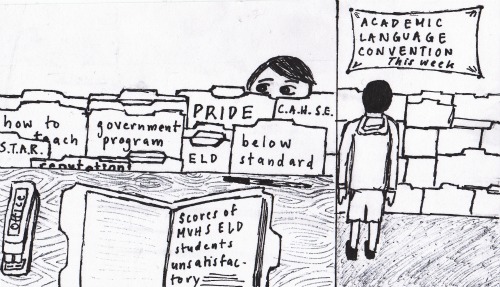As we all must know by now, our teachers are attending workshops this week about improving academic language. Or so we’ve been told.

- The reality of this school’s academic imperfection is inconsistent with the facade that administration has promoted. This is unnecessary and even detrimental to solving the problem. Illustration by Smitha Gundavajhala.
In reality, this has been a part of the government’s efforts to improve the performance of English Language Development (ELD) students. Apparently the number of students at our school that are not passing the California High School Exit Exam and other standardized tests—tests in which most students take passing for granted—has increased, compared as other schools.
This seems counter-intuitive, right? That a school with such high API scores and such good rankings could have so many students that are not passing these tests?
Well, in order to achieve these stellar averages, more effort either has to be put into bringing up the lower level of performers or into improving the higher level. MVHS is guiltier of the latter, most probably because it has forgotten the lower levels of performers in its current success. To the rest of the world, MVHS is a conspicuously high-performing school, but it cannot be so when the reality is that there is a high enough percentage of students not passing their required tests. It is understandable, politically, that teachers would put more time into those students in which they can see phenomenal results—much as professors do in college when favoring students that are more likely to do research for them.
But this is a public school system—a government institution. The fact that the government has decided to intervene in this matter to institute this program shows that it has gotten out of hand. It is the job of the teacher to ensure that students are up to par, if only with state standards. They may be challenging us to learn on our own, but they are still held to certain standards as teachers.
This is perhaps the reason why administration and staff have been embarrassed, or at least evasive, to release this information. While they may not be directly at fault, it is also true that they could be doing more. If they do decide to trust higher-performing students to do well—not exceptionally, but well—on their own, and give more attention to those that need it, then MVHS could establish an even greater standard for performance—and one that is met by more students.
It is an achievable goal, and the first step to solving any problem is acknowledging it. As long as the administration attempts to keep this situation behind closed doors and the students are not informed of the situation, the problem will become more deeply entrenched at this school. So let us acknowledge, embrace and work towards the needed improvement of the performance of ELD students at MVHS.
The problem exists. It is now up to us whether we want to be a part of the solution.








